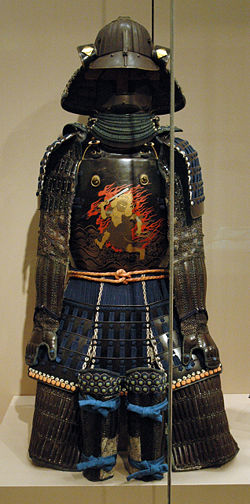- Hotoke Do
-
Hotoke Do 
Angaben Waffenart: Schutzwaffe Bezeichnungen: Hotoke Do, Brustplatte des Heiligen Verwendung: Waffe Einsatzzeit: etwa 16. Jahrhundert Ursprungsregion/
Urheber:Japan, Waffenschmiede Verbreitung: Japan Listen zum Thema Der Hotoke Do auch engl. Buddha's torso, Brustplatte des Heiligen ist ein Brustpanzer (Do) der von japanischen Samurai zu ihren Rüstungen getragen wurde.
Inhaltsverzeichnis
Beschreibung
Der Hotoke Do ist ein Brustpanzer, der im Gegensatz zu anderen japanischen Rüstungen aus einer Platte gearbeitet wurde. Auf diese Platte wurde ein Überzug aus Leder aufgebracht, der leicht zu Bearbeiten war. Dadurch war es möglich Strukturen zur Verzierung in das Leder einzuarbeiten oder aufzutragen. Ebenfalls wurden die Brustpanzer lackiert und feine Lackarbeiten aufgetragen. Der Name stammt von den runden, wohlgenährten Bäuchen der Priester und Mönche aus den Klöstern, sowie von Statuen Buddahs. Die Form des Hotoke Do wurde von europäischen Rüstungen übernommen[1].
Einzelnachweise
- ↑ Oscar Ratti, Adele Westbrook, Secrets of the samurai: a survey of the martial arts of feudal Japan, Verlag Tuttle Publishing, 1991, Seite 202, ISBN 978-0-8048-1684-7
Literatur
- George Cameron Stone, Donald J. LaRocca, A Glossary of the Construction, Decoration and Use of Arms and Armor: in All Countries and in All Times, Verlag Courier Dover Publications, 1999, Seite 301, 302, ISBN 978-0-486-40726-5
- Ian Bottomley, Anthony Hopson, Arms and armor of the samurai: the history of weaponry in ancient Japan, Verlag Crescent Books, 1993, ISBN 9780517103180
Weblinks
Wikimedia Foundation.
